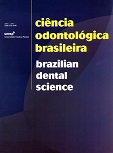Evaluation of linear alteration of NiCr castings using two phosphate - bonded investments with different compositions
DOI:
https://doi.org/10.14295/bds.2004.v7i4.210Abstract
The aim of this work was to verify the linear alteration of castings using two phosphate – bonded investments, one with granuled ceramic – based refractory (Microfine 1700), and the other by cristobalite (Bellavest – T). Forty wax patterns were obtained through direct molding from a stainless steel matrix. Twenty wax patterns were invested with Microfine and twenty with Bellavest – T. A profile projector measured the distance between two points pre- established on the matrix. The same two points were measured later on the metal casting reproduced in NiCr, thus obtaining the measurement of possible dimensional changes. Along the experiment, wax patterns were measured and compared to the stainless steel matrix and to the NiCr castings. The results show that the two investments could not compensate the contraction of the alloy and wax in the casting process. The mean distance of the castings obtained with Microfine 1700, despite the fact of being smaller than the matrix and the castings of Bellavest – T, showed more constant dimensions.
Downloads
Downloads
Published
How to Cite
Issue
Section
License
Brazilian Dental Science uses the Creative Commons (CC-BY 4.0) license, thus preserving the integrity of articles in an open access environment. The journal allows the author to retain publishing rights without restrictions.
=================




























